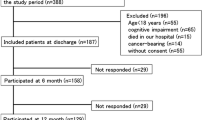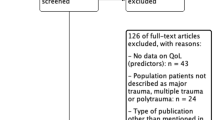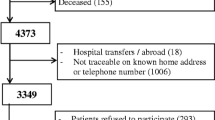Abstract
Purpose
This study aimed to assess the health-related quality of life (HRQOL) in trauma patients 2 years after discharge from an intensive care unit (ICU) in Zunyi, China, and to investigate the possible determinants of HRQOL.
Methods
A total of 436 trauma patients treated in the ICU were followed up for 2 years. The Medical Outcomes Study Short Form 36 (SF-36) was used to measure the quality of life 1 and 2 years after their discharge.
Results
After a 2-year follow-up, there were, in total, 347 (79.6%) survivors. From 1 to 2 years after discharge, the HRQOL improved in one physical health domain and three mental health domains. Logistic regression showed that female patients had lower mental component summary (MCS) scores (odds ratio [OR] = 1.9, 95% confidence interval [CI]: 1.2–3.0). Patients older than 40 years had lower scores in the physical component summary (PCS) (OR = 1.7, 95% CI: 1.1–2.7). Patients who stayed in the ICU for longer than 7 days had lower PCS scores (OR = 1.6, 95% CI: 1.0–2.5). The association between head injury and low MCS scores was statistically significant (OR = 1.8, 95% CI: 1.1–2.9). Patients with an Injury Severity Score (ISS) > 24 had lower scores in the PCS (OR = 1.9, 95% CI: 1.2–3.1).
Conclusions
The HRQOL of a group of Chinese trauma patients after ICU treatment improved from 1 to 2 years after discharge. Age, sex, length of ICU stay, ISS, and existence of head injury were associated with physical or mental HRQOL after discharge. Further studies with more measurements and larger sample sizes are still warranted.
Similar content being viewed by others
References
Niskanen M, Kari A, Halonen P. Five-year survival after intensive care—comparison of 12,180 patients with the general population. Finish ICU Study Group. Crit Care Med. 1996;24:1962–7.
Heyland DK, Kutsogiannis DJ. Quality of life following critical care: moving beyond survival. Intensive Care Med. 2000;26:1172–5.
Dowdy DW, Eid MP, Sedrakyan A, Mendez-Tellez PA, Pronovost PJ, Herridge MS, Needham DM. Quality of life in adult survivors of critical illness: a systematic review of the literature. Intensive Care Med. 2005;31:611–20.
Graf J, Koch M, Dujardin R, Kersten A, Janssens U. Health-related quality of life before, 1 month after, and 9 months after intensive care in medical cardiovascular and pulmonary patients. Crit Care Med. 2003;31:2163–9.
Kaarlola A, Pettilä V, Kekki P. Quality of life six years after intensive care. Intensive Care Med. 2003;29:1294–9.
Pettilä V, Kaarlola A, Mäkeläinen A. Health-related quality of life of multiple organ dysfunction patients one year after intensive care. Intensive Care Med. 2000;26:1473–9.
Wehler M, Geise A, Hadzionerovic D, Aljukic E, Reulbach U, Hahn EG, Strauss R. Health-related quality of life of patients with multiple organ dysfunction: individual changes and comparison with normative population. Crit Care Med. 2003;31:1094–101.
Eddleston JM, White P, Guthrie E. Survival, morbidity, and quality of life after discharge from intensive care. Crit Care Med. 2000;28:2293–9.
García Lizana F, Peres Bota D, De Cubber M, Vincent JL. Long-term outcome in ICU patients: what about quality of life? Intensive Care Med. 2003;29:1286–93.
Sluys K, Häggmark T, Iselius L. Outcome and quality of life 5 years after major trauma. J Trauma. 2005;59:223–32.
Granja C, Dias C, Costa-Pereira A, Sarmento A. Quality of life of survivors from severe sepsis and septic shock may be similar to that of others who survive critical illness. Crit Care. 2004;8:R91–8.
Abelha FJ, Santos CC, Maia PC, Castro MA, Barros H. Quality of life after stay in surgical intensive care unit. BMC Anesthesiol. 2007;7:8.
Kvåle R, Flaatten H. Changes in health-related quality of life from 6 months to 2 years after discharge from intensive care. Health Qual Life Outcomes. 2003;1:2.
Tian ZM, Miranda DR. Quality of life after intensive care with the sickness impact profile. Intensive Care Med. 1995;21:422–8.
Ware JE, Snow KK, Kosinski M, Gandek B. SF-36 health survey: manual and interpretation guide. Boston: The Health Institute; 1993.
Baker SP, O’Neill B, Haddon W Jr, Long WB. The injury severity score: a method for describing patients with multiple injuries and evaluating emergency care. J Trauma. 1974;14:187–96.
Le Gall JR, Lemeshow S, Saulnier F. A new Simplified Acute Physiology Score (SAPS II) based on a European/North American multicenter study. JAMA. 1993;270:2957–63.
Li L, Wang HM, Shen Y. Chinese SF-36 Health Survey: translation, cultural adaptation, validation, and normalisation. J Epidemiol Community Health. 2003;57:259–63.
Ringdal M, Plos K, Ortenwall P, Bergbom I. Memories and health-related quality of life after intensive care: a follow-up study. Crit Care Med. 2010;38:38–44.
Cuthbertson BH, Roughton S, Jenkinson D, Maclennan G, Vale L. Quality of life in the five years after intensive care: a cohort study. Crit Care. 2010;14:R6.
Ridley SA, Chrispin PS, Scotton H, Rogers J, Lloyd D. Changes in quality of life after intensive care: comparison with normal data. Anaesthesia. 1997;52:195–202.
Flaatten H, Kvåle R. Survival and quality of life 12 years after ICU. A comparison with the general Norwegian population. Intensive Care Med. 2001;27:1005–11.
Vedio AB, Chinn S, Warburton FG, Griffiths MP, Leach RM, Treacher DF. Assessment of survival and quality of life after discharge from a teaching hospital general intensive care unit. Clin Intensive Care. 2000;11:39–46.
Vazquez Mata G, Rivera Fernandez R, Perez Aragon A, Gonzalez Carmona A, Fernandez Mondejar E, Navarrete Navarro P. Analysis of quality of life in polytraumatized patients two years after discharge from an intensive care unit. J Trauma 1996;41:326–32.
Ulvik A, Kvåle R, Wentzel-Larsen T, Flaatten H. Quality of life 2–7 years after major trauma. Acta Anaesthesiol Scand. 2008;52:195–201.
Badia X, Diaz-Prieto A, Gorriz MT, Herdman M, Torrado H, Farrero E, Cavanilles JM. Using the EuroQol-5D to measure changes in quality of life 12 months after discharge from an intensive care unit. Intensive Care Med. 2001;27:1901–7.
Conflict of interest
The authors declare that there is no actual or potential conflict of interest in relation to this article.
Author information
Authors and Affiliations
Corresponding author
Rights and permissions
About this article
Cite this article
Fu, XY., Chen, M., Yu, T. et al. Health-related quality of life of trauma patients after intensive care: a 2-year follow-up study. Eur J Trauma Emerg Surg 37, 629–633 (2011). https://doi.org/10.1007/s00068-011-0084-7
Received:
Accepted:
Published:
Issue Date:
DOI: https://doi.org/10.1007/s00068-011-0084-7




